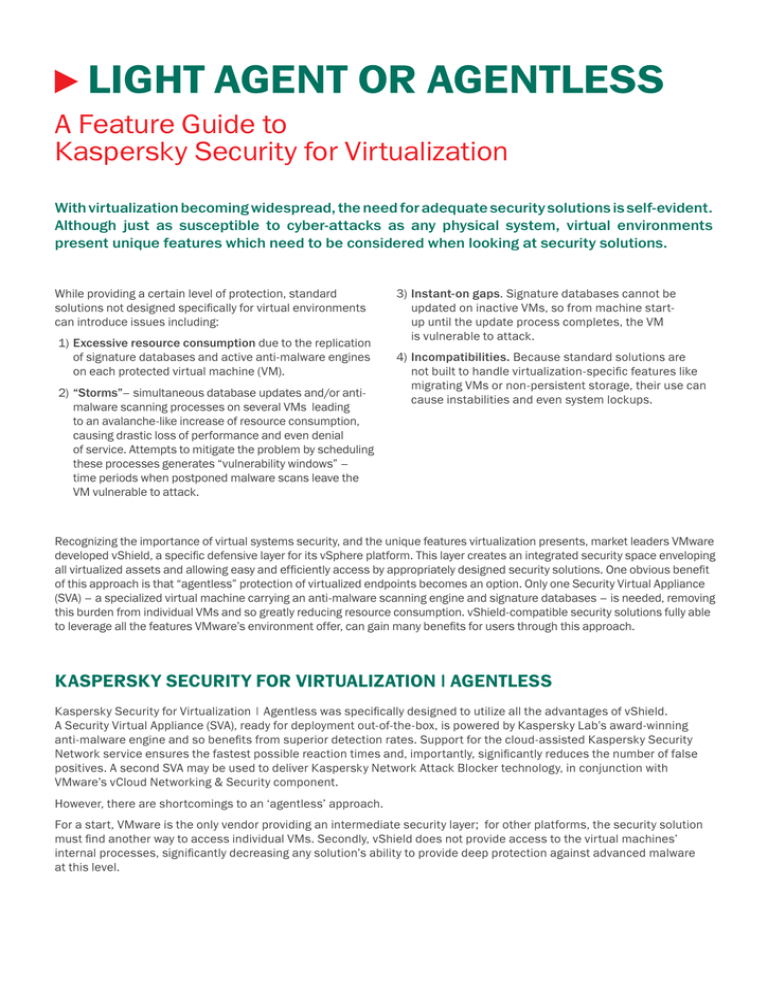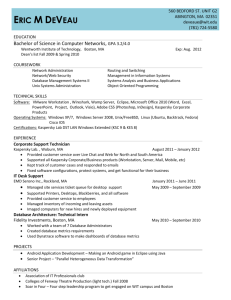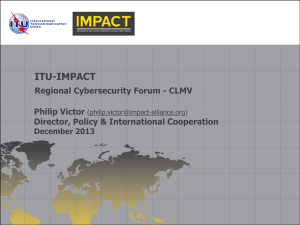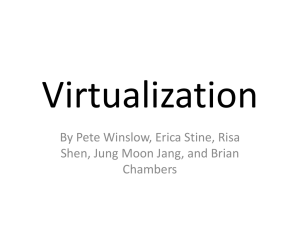
LIGHT AGENT OR AGENTLESS
A Feature Guide to
Kaspersky Security for Virtualization
With virtualization becoming widespread, the need for adequate security solutions is self-evident.
Although just as susceptible to cyber-attacks as any physical system, virtual environments
present unique features which need to be considered when looking at security solutions.
While providing a certain level of protection, standard
solutions not designed specifically for virtual environments
can introduce issues including:
1)Excessive resource consumption due to the replication
of signature databases and active anti-malware engines
on each protected virtual machine (VM).
2)“Storms”– simultaneous database updates and/or antimalware scanning processes on several VMs leading
to an avalanche-like increase of resource consumption,
causing drastic loss of performance and even denial
of service. Attempts to mitigate the problem by scheduling
these processes generates “vulnerability windows” –
time periods when postponed malware scans leave the
VM vulnerable to attack.
3)Instant-on gaps. Signature databases cannot be
updated on inactive VMs, so from machine startup until the update process completes, the VM
is vulnerable to attack.
4)Incompatibilities. Because standard solutions are
not built to handle virtualization-specific features like
migrating VMs or non-persistent storage, their use can
cause instabilities and even system lockups.
Recognizing the importance of virtual systems security, and the unique features virtualization presents, market leaders VMware
developed vShield, a specific defensive layer for its vSphere platform. This layer creates an integrated security space enveloping
all virtualized assets and allowing easy and efficiently access by appropriately designed security solutions. One obvious benefit
of this approach is that “agentless” protection of virtualized endpoints becomes an option. Only one Security Virtual Appliance
(SVA) – a specialized virtual machine carrying an anti-malware scanning engine and signature databases – is needed, removing
this burden from individual VMs and so greatly reducing resource consumption. vShield-compatible security solutions fully able
to leverage all the features VMware’s environment offer, can gain many benefits for users through this approach.
KASPERSKY SECURITY FOR VIRTUALIZATION | AGENTLESS
Kaspersky Security for Virtualization | Agentless was specifically designed to utilize all the advantages of vShield.
A Security Virtual Appliance (SVA), ready for deployment out-of-the-box, is powered by Kaspersky Lab’s award-winning
anti-malware engine and so benefits from superior detection rates. Support for the cloud-assisted Kaspersky Security
Network service ensures the fastest possible reaction times and, importantly, significantly reduces the number of false
positives. A second SVA may be used to deliver Kaspersky Network Attack Blocker technology, in conjunction with
VMware’s vCloud Networking & Security component.
However, there are shortcomings to an ‘agentless’ approach.
For a start, VMware is the only vendor providing an intermediate security layer; for other platforms, the security solution
must find another way to access individual VMs. Secondly, vShield does not provide access to the virtual machines’
internal processes, significantly decreasing any solution’s ability to provide deep protection against advanced malware
at this level.
KASPERSKY SECURITY CENTER
KSV
Security Virtual
Appliance —
ANTI-MALWARE
App
App
App
App
OS
OS
OS
OS
vShield
KSN
KSV
Security Virtual
Appliance —
NET ATTACK
BLOCKER
vCloud Networking & Security
ESXi
VIRTUAL MACHINES
VMWARE LEVEL
HYPERVISOR
Physical Host
HARDWARE LEVEL
To overcome these limitations, another approach was introduced, deploying a small light-weight application to the VM being
protected in addition to the SVA. This application is known as a “light agent”. With the file scanning engine and databases
still held centrally, this application has very much smaller footprint on the VM memory than a full agent solution, while
providing access not just to the VM’s file system, but to its memory and internal processes. As a result, additional, more
advanced security techniques can be employed.
KASPERSKY SECURITY FOR VIRTUALIZATION | LIGHT AGENT
Kaspersky Security for Virtualization | Light Agent was created for all three of the most popular virtualization platforms;
Citrix, Microsoft Hyper-V and VMware. The anti-malware scanner and the signature databases reside on a dedicated SVA,
just as with agentless technology, freeing up resources for the deployment of additional VMs so consolidation ratios are
optimized. And, with a light agent operating inside each guest OS, it becomes possible to employ most of the advanced
technologies available to physical machines through Kaspersky Endpoint Security for Business. A full set of endpoint
controls can be deployed, as well as HIPS (Host-Based Intrusion Prevention System), a proprietary Firewall and a Systems
Management toolset. A powerful multi-layered defensive perimeter, capable of dealing with the most sophisticated
examples of malware and even with zero-day threats, is created.
Of course, while providing a higher level of protection, the Light Agent solution may appear ‘heavier’ than its Agentless
counterpart, and it does require a little more attention when deploying new VMs. But even these issues are not as
straightforward as they appear.
For a better understanding, we need to look deeper into the functionality of both Agentless and Light Agent solutions, and
the threats they are designed to counter.
KASPERSKY SECURITY CENTER
VM
KSN
KSV
VM
MEMORY ACCESS
HIPS, AEP, FIREWALL
APP/WEB/DEVICE CTRLS
VIRTUAL MACHINES
Security Virtual Appliance —
SIGNATURE DATABASES AND
FILE-LEVEL ANTI-MALWARE
Microsoft Hyper-V / Citrix XenServer / VMware
Physical Host
HYPERVISOR
HARDWARE LEVEL
THREATS VS. FEATURES
Virtual machines are every bit as vulnerable as their physical counterparts – perhaps even more so: in lightning-fast
virtualized networks, the spread of infection can be devastating. So it’s important to identify the security weaknesses in your
virtual infrastructure, and to deploy adequate measures in proportion to the potential threats. Below, we examine potential
threats to virtual systems, and the technologies used to counteract them.
MALWARE EXECUTABLES
Whether it’s an insidiously crafted attachment received
via email, infected leisureware or a temporary malwarecreated executable – Anti-Malware is essential to deal with
these basic threats. The malware-fighting engine is the core
technology of both Agentless and Light Agent configurations
of Kaspersky Security for Virtualization, though it reaches
into the protected VM’s file systems through different means
in each case.
Another way to prevent malware agents from harming your
virtualized assets is through Application Control with Dynamic
Whitelisting. When only legitimate and safe software is
allowed to run, malware is stopped in its tracks. Kaspersky
Security for Virtualization | Light Agent allows Application
Control to be enabled on VMs, although Kaspersky Security
for Virtualization | Agentless, operating through vShield, is
not able to support endpoint controls.
BODILESS MALWARE
Some sophisticated malware does not have a ‘body’ – which
means there’s nothing to be found in the file system. Spawned
by a previously launched executable or injected via an exploit,
this malware cannot be detected by traditional anti-malware.
Advanced anti-malware counter-measures, able to watch over
processes in the memory and immediately block programs
engaged in any suspicious or outright dangerous activity, are
required. Kaspersky Security for Virtualization | Light Agent
is armed with a range of technologies able to block incursions
into the VM’s memory. These include:
•
•
•
System Watcher, which monitors program behavior,
tracing system events. This is supported by
BSS – Behavioral Stream Signatures, identifying
behavior patterns characteristic to malware activity.
Privilege Control, restricting application from making
unsolicited changes, including process injection.
These tools allow the Host-based Intrusion Protection
System (HIPS) to track down and stop rogue processes
in VM memory.
Kaspersky Security for Virtualization | Agentless is only
capable of tracing changes at file system level, due to vShield
API limitations.
EXPLOITS
The exploitation of vulnerabilities found in systems
components and popular applications remains among the
most effective attack mechanisms. While it is possible to
thwart these incursions using the technologies listed above,
the affected program may operate at a high privilege level,
limiting control over its activities.
The most effective method of tackling this threat is to
prevent the exploits from doing what their name implies –
exploiting the vulnerabilities in the first place. This is
achieved through recognizing the sequence of actions
characteristic to exploits as they take place; as performed
by Kaspersky’s Automatic Exploit Prevention (AEP). The
efficiency of this technology was proved by a series of
independent tests performed by MRG Effitas institute.
These tests found that, even with all other protective
components switched off, Kaspersky’s AEP technology
remained 100% effective against exploit-using attacks.
Even unknown, zero-day exploits are blocked by this
proactive technology.
Kaspersky Security for Virtualization | Light Agent
is equipped with this advanced feature, which makes
it particularly useful in Virtual Desktop Infrastructures
(VDI) employed to replace physical desktops – with their
commensurately higher risks of drive-by infections.
Kaspersky Security for Virtualization | Agentless must
rely on vShield capabilities, which lack features similar to
Kaspersky AEP.
ROOTKITS
Sophisticated malware is often capable of hiding itself,
preventing detection by traditional anti-malware with the
help of so called “bootkits” and “rootkits”. These insidious
tools try to load malware as early as possible, so it remains
undiscovered through gaining high privileges within the
system. Kaspersky’s Anti-Rootkit technology is able to detect
and eradicate even such deeply hidden malware. It operates
both in memory and at file system level, requiring access to
the guest machine’s RAM and processes to operate.
Kaspersky Security for Virtualization | Light Agent can offer
this technology, because it has full access to guest machine
resources.
Kaspersky Security for Virtualization | Agentless can only
access the file system, so lacks full anti-rootkit capability.
NETWORK ATTACKS
There are threats that take advantage of networking system
features, allowing the attacker to obtain crucial information
about the network under attack, gain access to the targeted
system’s resources or interfere with its smooth operation.
These include port scanning, denial-of-service attacks, bufferunderrun attacks and other malicious actions. Such attacks
require specialized counter-measures of the sort provided by
Kaspersky’s Network Attack Blocker. As the name suggests,
this technology stops incoming network attacks, with the help
of an IDS (Intrusion Detection System), by utilizing heuristic
algorithms to discern even the most complex attack patterns.
Both Kaspersky Security for Virtualization | Agentless and
Kaspersky Security for Virtualization | Light Agent have
these network technologies in their arsenals.
MALICIOUS WEBSITES
DATA LEAKAGE
One of the most common sources of infection is a malicious,
or infected, website. Though this rarely affects virtualized
servers, it may pose a serious threat to desktopreplacement VDI if users are allowed full Internet access.
This is where Kaspersky’s web technologies come into
play. Anti-phishing prevents users from accessing websites
reported as dangerous, using information obtained via
Kaspersky Security Network and continuously updated
with the help of millions of KSN’s voluntary participants
around the globe. As yet undiscovered phishing sites are
also blocked, thanks to a heuristic engine that analyzes the
source text of the loaded page, detecting signs of malicious
code. Web Control technology has the added benefit of
restricting access to non-work-related websites, such as
gaming or social networks, preventing users from wasting
precious time on non-working activities.
Corporate secrets leaking from an IT network may inflict great
harm on a business, including reputational damage that may
have long-lasting and painful consequences. So restricting
the number of ways in which information is shared may
become necessary. Both Kaspersky’s Application Control
and Device Control are useful here. Application control can
prevent dangerous applications, such as instant messengers
or file hosting and P2P client apps, from running, while device
control restricts the use of external storage, which may be
used to ship out sensitive data.
Kaspersky Security for Virtualization | Agentless does not
possess these host-based features, but Kaspersky Security
for Virtualization | Light Agent does, making it more suitable
for VDIs with access to the Internet.
PERIPHERALS-BASED ATTACKS
Traditionally, one of the most effective methods of
introducing an infection into an IT network is through
external storage. While network-delivered infections now
appear the greater threat in terms of sheer numbers,
external storage still remains a significant danger –
especially so when part of carefully planned targeted
attack. It’s worth mentioning that ungoverned non-storage
peripherals can also pose a threat; known cases include,
for example, infected printer firmware. And external
storage drives remain among the leading methods for your
confidential data to leave the building.
While it is not usually easy for an unauthorized person
to gain access to the physical machines hosting the virtual
infrastructure, it is still possible – and there are business
cases where such a possibility is considered too high a risk.
And, in terms of desktop-replacement VDI, even the most
simple thin-clients may have USB ports.
So controlling peripherals becomes a sensible precaution –
and is easily accomplished through Kaspersky’s Device
Control technology. This allows the prevention or restriction
in use of specific device and bus types. And of course
exceptions can be configured, so that peripherals essential
for work can still be used.
As with other Control technologies, Device Control is offered
in Kaspersky Security for Virtualization | Light Agent, but
not in Kaspersky Security for Virtualization | Agentless.
© 2014 Kaspersky Lab ZAO. All rights reserved.
Registered trademarks and service marks are the property of their respective owners.
As above, these two technologies are included in Kaspersky
Security for Virtualization | Light Agent but cannot be
offered in Kaspersky Security for Virtualization | Agentless.
AGENTLESS VS LIGHT AGENT: WHICH IS BETTER?
For some readers the answer may seem very clear:
Kaspersky Security for Virtualization | Light Agent
is packed with advanced features which are not included
in Kaspersky Security for Virtualization | Agentless – so
the light agent solution is obviously the better. But don’t jump
to conclusions; it’s a little more complicated than this.
First, there’s the matter of instant protection offered by
Kaspersky Security for Virtualization | Agentless. Virtual
machines become protected from the very moment of
startup, which may be critical if you already have infection
running amok in your virtualized network (and your VM cannot
be raised from an image containing the Light Agent app).
Then again, in some cases Kaspersky Security for
Virtualization | Light Agent may yield to Kaspersky
Security for Virtualization | Agentless in the terms
of performance. To choose the best security option for
your virtual installation and to gain the most from your
virtualization project, you’ll need to weigh up carefully the
potential threats, the value of data being protected and the
different layers of protection required.*
Please note that any combination of agentless protection
for VMware and light agent based security for any or all
three platforms is covered by a single Kaspersky Security
for Virtualization license. Whether you’re employing Citrix,
VMware or Microsoft, all are under your control within the
comfortable “single pane-of-glass” interface of Kaspersky
Security Center.
* Read “Kaspersky Security for Virtualization: Understand the Difference” whitepaper
for more details on choosing the best combination of Kaspersky solutions for
securing your virtual infrastructure.




